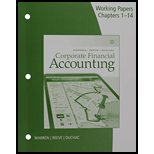
Working Papers for Warren/Reeve/Duchac's Corporate Financial Accounting, 14th
14th Edition
ISBN: 9781305878839
Author: Carl Warren, Jonathan Duchac, James M. Reeve
Publisher: Cengage Learning
expand_more
expand_more
format_list_bulleted
Question
Chapter 11, Problem 11.9EX
A.
To determine
Present Value: The value of today’s amount expected to be paid or received in the future at a compound interest rate is called as present value.
To calculate: The present value of $200,000 (Future amount).
B.
To determine
To calculate: The present value of $200,000 (Future amount) by using present value table in Exhibit 7.
C.
To determine
To explain: The reason why present value of four $200,000 cash receipts is less than $800,000 to be received in future.
Expert Solution & Answer
Trending nowThis is a popular solution!

Students have asked these similar questions
General Accounting
Solve this question
Given answer general Accounting
Chapter 11 Solutions
Working Papers for Warren/Reeve/Duchac's Corporate Financial Accounting, 14th
Ch. 11 - Describe the two distinct obligations incurred by...Ch. 11 - Explain the meaning of each of the following terms...Ch. 11 - If you asked your broker to purchase for you a 12%...Ch. 11 - A corporation issues 26,000,000 of 9% bonds to...Ch. 11 - If bonds issued by a corporation are sold at a...Ch. 11 - Prob. 6DQCh. 11 - Bonds Payable has a balance of 5,000,000 and...Ch. 11 - Prob. 8DQCh. 11 - Prob. 9DQCh. 11 - Issuing bonds at face amount On January 1, the...
Ch. 11 - Issuing bonds at a discount On the first day of...Ch. 11 - Prob. 11.3BECh. 11 - Prob. 11.4BECh. 11 - Prob. 11.5BECh. 11 - Redemption of bonds payable A 500,000 bond issue...Ch. 11 - Prob. 11.1EXCh. 11 - Entries for issuing bonds Thomson Co. produces and...Ch. 11 - Prob. 11.3EXCh. 11 - Prob. 11.4EXCh. 11 - Entries for issuing and calling bonds; loss Hoover...Ch. 11 - Entries for issuing and calling bonds; gain Mia...Ch. 11 - Prob. 11.7EXCh. 11 - Present value of amounts due Assume that you are...Ch. 11 - Prob. 11.9EXCh. 11 - Present value of an annuity On January 1 you win...Ch. 11 - Prob. 11.11EXCh. 11 - Prob. 11.12EXCh. 11 - Present value of bonds payable; premium Moss Co....Ch. 11 - Amortize discount by interest method On the first...Ch. 11 - Amortize premium by interest method Shunda...Ch. 11 - Prob. 11.16EXCh. 11 - Prob. 11.17EXCh. 11 - Bond discount, entries for bonds payable...Ch. 11 - Prob. 11.2APRCh. 11 - Entries for bonds payable, including bond...Ch. 11 - Prob. 11.4APRCh. 11 - Prob. 11.5APRCh. 11 - Bond discount, entries for bonds payable...Ch. 11 - Prob. 11.2BPRCh. 11 - Prob. 11.3BPRCh. 11 - Bond discount, entries for bonds payable...Ch. 11 - Prob. 11.5BPRCh. 11 - Continuing Company AnalysisAmazon: Times interest...Ch. 11 - Arch Coal:Times interest earned Arch Coal, Inc. is...Ch. 11 - Aeropostale: Times interest earned Aeropostale,...Ch. 11 - Prob. 11.4ADMCh. 11 - Ethics in Action CLG Capital Inc. is a large...Ch. 11 - Prob. 11.3TIF
Knowledge Booster
Similar questions
arrow_back_ios
SEE MORE QUESTIONS
arrow_forward_ios
Recommended textbooks for you
 Cornerstones of Financial AccountingAccountingISBN:9781337690881Author:Jay Rich, Jeff JonesPublisher:Cengage Learning
Cornerstones of Financial AccountingAccountingISBN:9781337690881Author:Jay Rich, Jeff JonesPublisher:Cengage Learning EBK CONTEMPORARY FINANCIAL MANAGEMENTFinanceISBN:9781337514835Author:MOYERPublisher:CENGAGE LEARNING - CONSIGNMENT
EBK CONTEMPORARY FINANCIAL MANAGEMENTFinanceISBN:9781337514835Author:MOYERPublisher:CENGAGE LEARNING - CONSIGNMENT Financial Accounting: The Impact on Decision Make...AccountingISBN:9781305654174Author:Gary A. Porter, Curtis L. NortonPublisher:Cengage Learning
Financial Accounting: The Impact on Decision Make...AccountingISBN:9781305654174Author:Gary A. Porter, Curtis L. NortonPublisher:Cengage Learning

Cornerstones of Financial Accounting
Accounting
ISBN:9781337690881
Author:Jay Rich, Jeff Jones
Publisher:Cengage Learning

EBK CONTEMPORARY FINANCIAL MANAGEMENT
Finance
ISBN:9781337514835
Author:MOYER
Publisher:CENGAGE LEARNING - CONSIGNMENT

Financial Accounting: The Impact on Decision Make...
Accounting
ISBN:9781305654174
Author:Gary A. Porter, Curtis L. Norton
Publisher:Cengage Learning